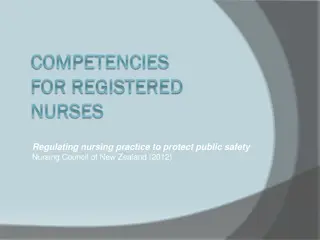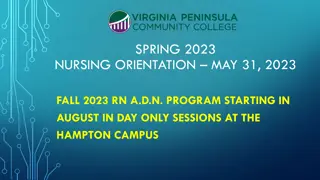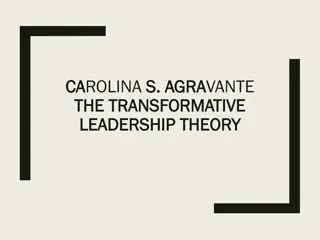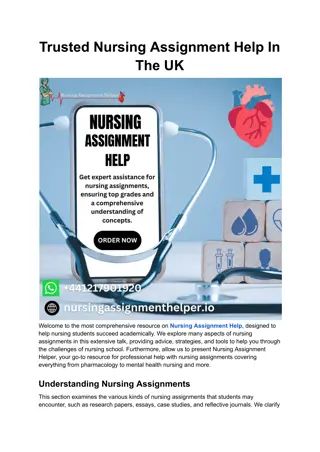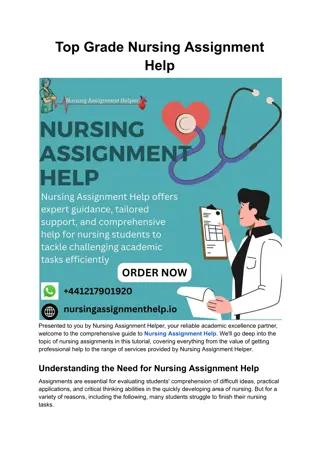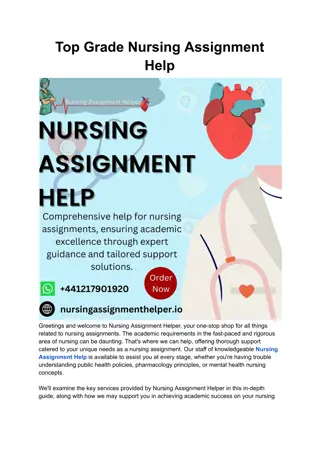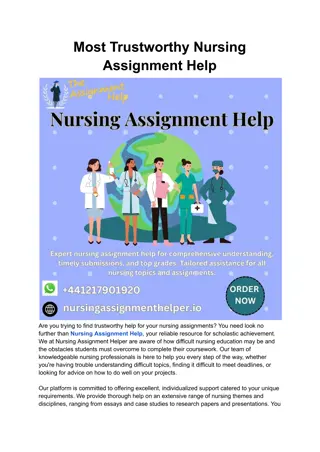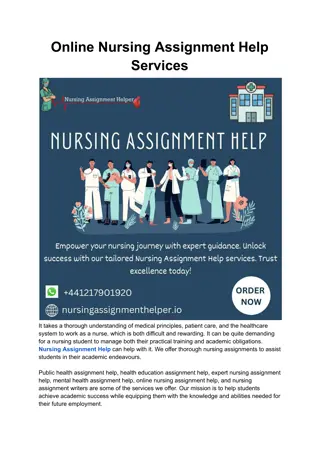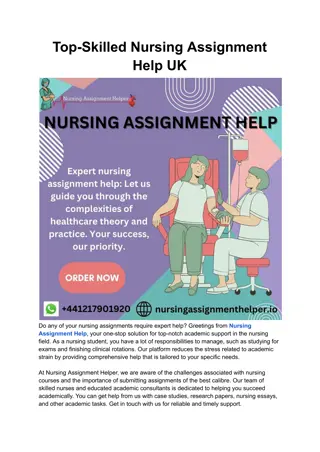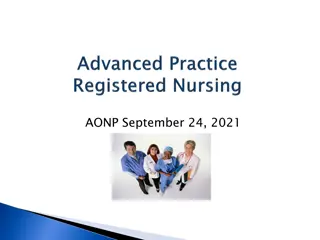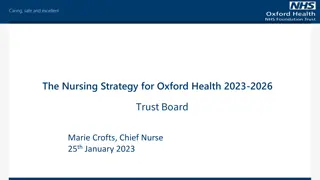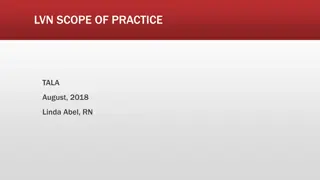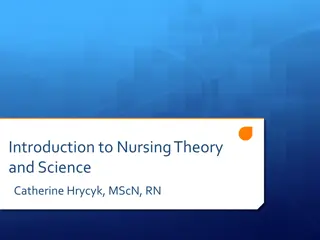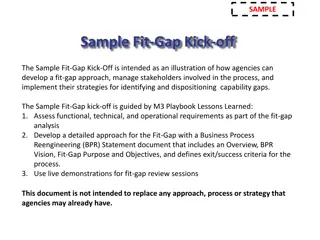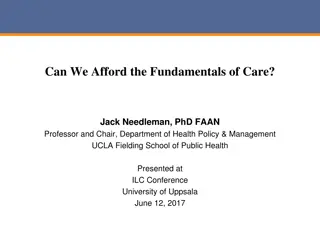Nursing Theory-Practice Gap: Challenges and Solutions
Exploring the enduring dichotomy between nursing theory and practice, the detrimental influence of unrealistic academic ideals on clinical settings, and the necessity of active engagement in the nursing profession to bridge the theory-practice gap effectively. Emphasizing the importance of leadership in nursing and the alignment with NHS requirements for a comprehensive approach to quality care delivery.
Download Presentation

Please find below an Image/Link to download the presentation.
The content on the website is provided AS IS for your information and personal use only. It may not be sold, licensed, or shared on other websites without obtaining consent from the author.If you encounter any issues during the download, it is possible that the publisher has removed the file from their server.
You are allowed to download the files provided on this website for personal or commercial use, subject to the condition that they are used lawfully. All files are the property of their respective owners.
The content on the website is provided AS IS for your information and personal use only. It may not be sold, licensed, or shared on other websites without obtaining consent from the author.
E N D
Presentation Transcript
Mel Gill Student Support & Guidance Tutor School of Education
Some students make the mistake of thinking that level 6 writing means using complex English and the longest words possible in order to show just how clever they are.
It is intuitive, therefore, that the fundamental dichotomy in theory and practice is inevitably exacerbated and irrevocably confounded by the underlying quixotic nature of nursing lecturers .
It seems obvious that the theory practice gap is always going to be made worse and become dreadfully confused by nursing lecturers who don t live in the real nursing world
Jones (2005) recently traced the theory practice gap in nursing. He argues that authors such as Brown (2001) and Raymond (1998) had identified the difficulty between the understanding of nursing theory and its actual implementation in clinical areas as being a divide which had existed from the time of Florence Nightingale s early interventions in the 1800 s. It seems, therefore, that this is a true dichotomy, a division between what is intended in theory and what actually occurs in practice. Fletcher (2004) argues that a possible source of this dichotomy may be nursing lecturers who retreat into academic environments and lose contact with the real world of the clinical environment. Hamilton (2001: 200) accused these lecturers of being quixotic , meaning that they were tilting uselessly at windmills like the confused hero of the story Don Quixote . This seems to suggest that these lecturers are actually confusing an already difficult situation by being unrealistic in their expectations and the focus of their attacks on the health system. Indeed, Worthing (2005) argues that a lecturer who does not also actively practice the nursing profession can make no useful contribution to the reduction of the theory practice gap .
Careful explanation, showing understanding of the complex terminology used Extensive use of literature to support the ideas being presented A linking, conversational style, which shows the student s own interpretation of what they have read and how it informs the argument being presented.
Brown (2005) maintains that leadership is an essential quality in nursing. This is confirmed by the recent requirements of the NHS Plan (DOH, 2002). This Plan has emphasized the importance of introducing the transformational model of leadership. Smith (2001) explains that this is a leadership which involves the use of charisma and interpersonal skills to enable achievement. Jones (2004) argues that the key characteristic of transformational leadership is empowering others to achieve. In my own experience, a leader with transformational qualities can make any team member feel that they have a useful part to play in the organization. This is confirmed by Fea (2001) who argues that transformational leadership increases feelings of self-worth and capability in their team members .
A review of the available literature provides a wealth of examples of authors advocating leadership as an essential quality in nursing. For example, as early as 1950 Shackleton emphasized that nursing needed strong leadership and recommended a strong transactional approach of reward and punishment to get results and promote teamwork. More recently, however, authors have been moving towards the concept of charismatic and transformational leadership. These qualities are also an integral part of the new recommendations laid down in the NHS Plan (DOH 2002). Charisma appears to be a complex phenomenon to define. Davidzhar (1991) suggests that it is an aspect of personality which makes the individual irresistible to others, in terms of their ability to persuade and empower others. However, other authors, such as Romano (1996) and Harvey (2000) highlight the intangible nature of charisma and emphasise the frustrating point that individuals know charisma if they see it, but find it difficult to define.
It appears problematic, therefore, to identify exactly how charisma can become an integral part of developing transformational leadership in nursing, if it is a quality which, in itself, is difficult to define. For example, Smith (2001) maintains that transformational leadership uses a combination of charisma and interpersonal skills to enable achievement. However, identifying potential transformational leaders may be a difficulty if the pre-requisite for identifying charismatic individuals is an integral part of this selection process. Jones (2004) argues that the key ability of a transformational leader is the ability to empower others, while Fea (2001) maintains that their key strength is to increase feelings of self-worth and capability in their team members. On reflection, my own experience of transformational leadership appeared to be based principally on being persuaded, by the sheer force of personality of the individual, that I had the potential to contribute and achieve. It seemed to me that it was their apparent faith in me and their power of persuasion that enabled me to become an effective team member.
This requirement for charisma in transformational leadership, therefore, may indeed be based on individual personality factors that enable others to feel good about themselves and their achievements. There is some evidence that this is the case. Jones (2003), for example, argues that transformational leaders are born and cannot be made. Regisara (2003) also maintains common key personality traits can be identified in effective transformational leaders, which have probably been present since childhood. It seems, therefore, that the key requirement of the NHS Plan (2002) for the training of transformational leaders is not going to be as straightforward as they first envisioned, as the available literature suggests that these leaders are born, rather than made .
Individual issues are explored in considerably more depth. (It is essential, therefore, in Level 6 writing to focus on a few key issues, so that they can be explored in sufficient depth within the available word allowance). The student should constantly be trying to find answers in the literature, particularly finding different definitions and interpretations of key issues Once the literature is presented, the student puts their own spin (interpretation) on it Personal thoughts and reflections are always followed up by attempts to find supporting evidence (substantiation) in the literature The complexity of the issue is recognised. Things are not presented simplistically as black and white . Instead, shades of grey are acknowledged. The student s voice is heard throughout, trying to make sense of what they have read and comparing it with what they have experienced.
Bysshe, J (2006) Rationale for Development of Academic Writing Guidelines Thames Valley University [Online] Available: http://www.google.co.uk/url?sa=t&rct=j&q=&esrc=s &source=web&cd=5&ved=0CEkQFjAE&url=http%3A %2F%2Fwww.wolfson.tvu.ac.uk%2Fschools%2Fnursi ng%2Fnursing%2520guidelines%2520for%2520academ ic%2520writing.doc&ei=1Xl7Uv_7LuWM0AXym4GA Cw&usg=AFQjCNHZ4ERNzSygGLqM7LjXFTAtwLZj xA&bvm=bv.56146854,d.d2k [Access date: 6.11.13]


